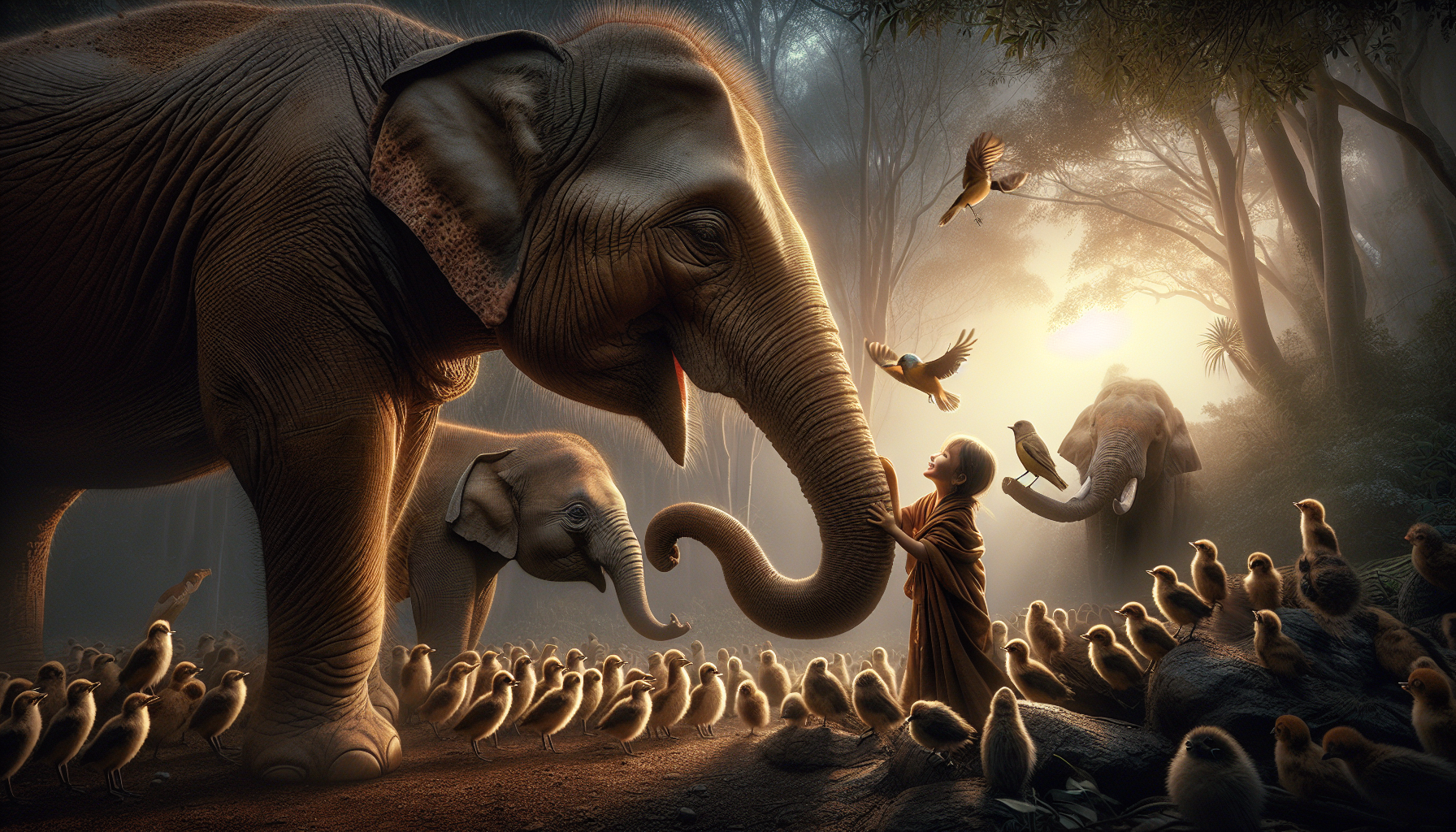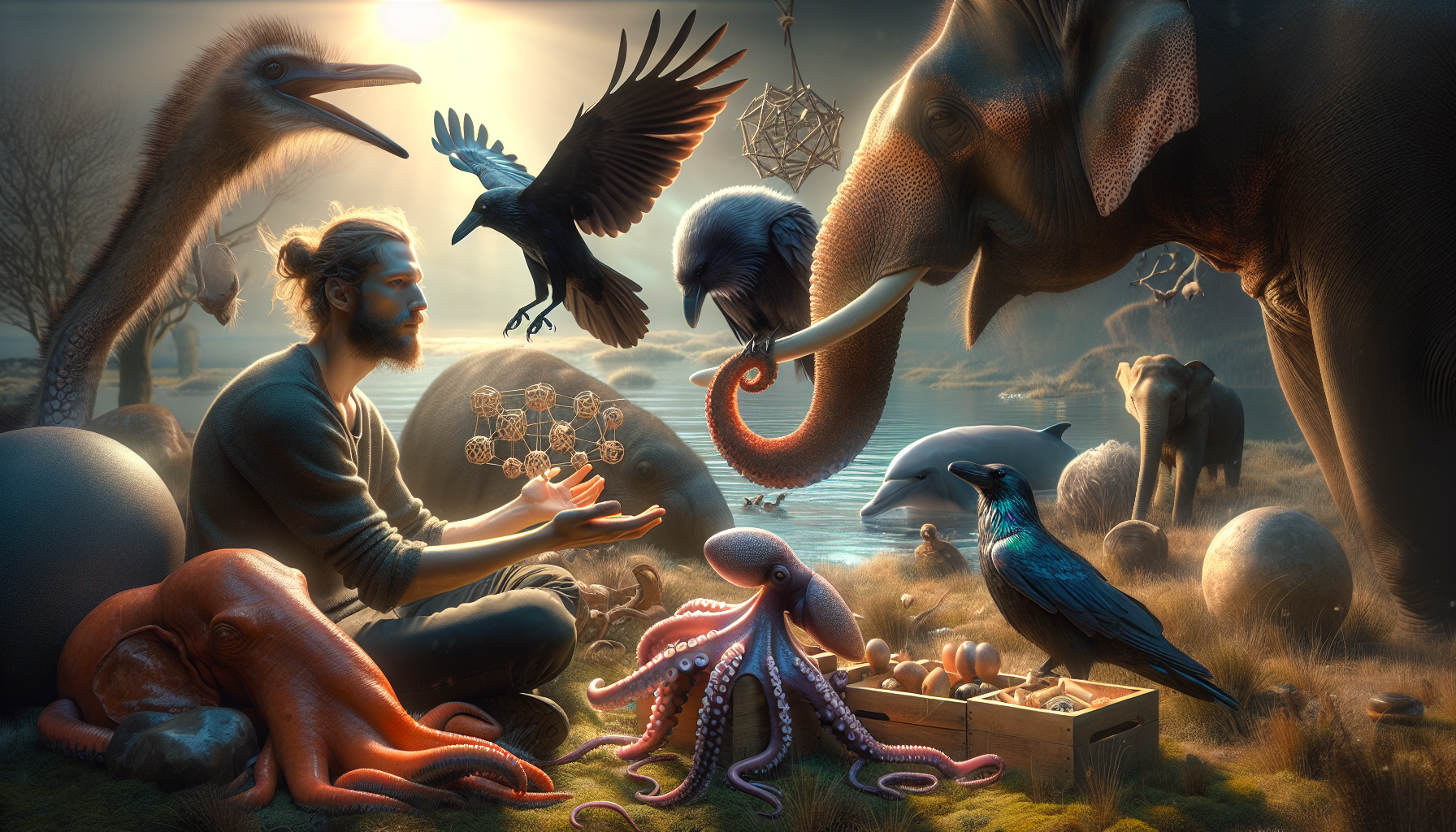In a world where humans often see themselves as the pinnacle of emotional complexity, the idea that animals possess rich emotional lives can be both humbling and enlightening. For centuries, we have shared our homes, environments, and sometimes our hearts with creatures of all kinds, yet we often underestimate the depth of their inner worlds. Welcome to the fascinating exploration of the emotional landscapes of animals, where behavior becomes a crucial window into understanding their feelings. This journey promises to challenge preconceived notions and reveal the profound emotional tapestry that binds us all together in the web of life.
At the heart of this exploration lies a simple yet profound question: Do animals feel emotions in the same way humans do? To uncover the truth, we must first strip away the anthropocentric lens through which we view the animal kingdom. Animals express their emotions not through words, but through behaviors and interactions that are rich in meaning if we take the time to observe and interpret them. From the joyful wag of a dog’s tail to the mournful cries of an elephant separated from its herd, these behaviors are more than mere instinct—they are expressions of joy, fear, love, and grief. 🐾
This article will delve into groundbreaking research that has shed light on the emotional lives of animals, exploring studies and real-world observations that bring us closer to understanding our non-human companions. We will examine the science behind animal emotions, looking at the neurological and physiological evidence that supports the existence of feelings across various species. Moreover, we will explore the ethical implications of acknowledging animal emotions, and how this knowledge can transform our relationships with the creatures we share this planet with. Whether it’s rethinking how we care for our pets or advocating for more humane treatment of wildlife, understanding animal emotions has far-reaching consequences for how we coexist with them.
Prepare to embark on a journey that will not only enrich your appreciation for the animals around you but also deepen your empathy and compassion for all living beings. Through the lens of behavior, we will unlock the emotional world of animals, inviting you to see them not as mere subjects of study but as sentient beings with whom we share a profound emotional connection. Together, let’s venture into this captivating exploration of feelings beyond words, where the silent language of behavior speaks volumes about the inner lives of animals. 🌿
The Science Behind Animal Emotions
Understanding the emotional world of animals is a complex yet fascinating endeavor that requires a deep dive into behavioral science and neurological studies. In recent years, scientists have made remarkable strides in deciphering the emotional cues and signals exhibited by animals, enabling a deeper understanding of their feelings and emotions. This field of study not only sheds light on animal welfare but also provides insights into human emotions, given the shared evolutionary pathways.
One pivotal aspect of this research involves the study of animal behavior as a window into their emotional states. Behavioral indicators such as vocalizations, body language, and social interactions serve as critical clues in understanding how animals experience and express emotions. For instance, dogs exhibit a unique range of facial expressions and body postures that can convey feelings of happiness, fear, or anxiety. Similarly, elephants are known for their complex social structures and display of emotions such as grief and joy, which are observable through their interactions and behaviors.
Neuroscientific studies further complement behavioral observations by exploring the brain structures and neural mechanisms that underlie emotional responses in animals. Comparative studies of mammalian brains have revealed that many animals, including primates, cetaceans, and even birds, possess neural architectures that support emotional processing. Structures like the amygdala and prefrontal cortex, which are integral to emotional regulation in humans, are also present in many animal species. This structural similarity suggests a shared evolutionary basis for emotions, providing a biological foundation for the behaviors observed.
Key Indicators of Animal Emotions
When delving into the emotional world of animals, it’s essential to identify the key indicators that reveal their feelings. Behavioral scientists focus on several primary markers that serve as reliable indicators of animal emotions. These markers include:
- Vocalizations: Different sounds and calls can indicate various emotional states. For example, purring in cats often signifies contentment, while high-pitched squeals in pigs can denote excitement or distress.
- Body Language: Postures and movements, such as wagging tails in dogs or arched backs in cats, are often clear signals of an animal’s emotional state.
- Facial Expressions: Subtle changes in facial expressions can reveal emotions. For example, chimpanzees display different facial expressions to communicate feelings such as playfulness or aggression.
- Social Interactions: The way animals interact with each other provides insights into their emotional lives. Elephants, for instance, are known to comfort distressed herd members through physical touch.
Understanding these indicators allows caregivers, veterinarians, and researchers to better assess and respond to the emotional needs of animals, improving their welfare and enriching their lives. For a detailed exploration of animal emotions, watch the enlightening video below:
The Emotional Lives of Animals – TEDx Talk by Dr. Jonathan Balcombe
Behavioral Studies: Unlocking Emotional Insights
Behavioral studies are at the forefront of exploring animal emotions, providing invaluable insights into how animals experience the world. These studies often involve observing animals in their natural habitats or controlled environments to identify patterns and correlations between behavior and emotional states.
One prominent study conducted on primates involved observing the social dynamics and emotional expressions of chimpanzees in the wild. Researchers found that chimpanzees exhibit a wide range of emotions, including empathy, anger, and sadness, which are expressed through gestures, vocalizations, and facial expressions. Such findings emphasize the complexity of primate emotions and challenge the notion that humans are the only species with rich emotional lives.
In marine mammals, particularly dolphins and whales, behavioral studies have uncovered profound emotional capabilities. Dolphins, for instance, are known for their playful behavior and strong social bonds. They engage in complex vocalizations and physical interactions that suggest a deep understanding of social dynamics and emotions. Similarly, whales have been observed displaying mourning behaviors, such as carrying dead calves, which indicate a profound sense of loss and grief.
Comparative Analysis of Behavioral Patterns
To further understand the emotional world of animals, it is beneficial to compare behavioral patterns across different species. The table below illustrates some common emotional behaviors and their manifestations in various animal species:
| Emotion | Behavioral Manifestation | Animal Species |
|---|---|---|
| Joy | Playful interactions, vocalizations | Dolphins, dogs |
| Fear | Avoidance behaviors, alarm calls | Deer, birds |
| Grief | Mourning behaviors, loss of appetite | Elephants, whales |
| Empathy | Comforting behaviors, shared distress | Primates, elephants |
By analyzing these patterns, researchers can gain a more nuanced understanding of how emotions manifest across different species and what this reveals about their inner experiences. This comparative approach not only enriches our knowledge of animal emotions but also highlights the evolutionary continuity of emotional expressions among animals and humans. Feel free to explore more about the emotional intelligence of animals through the resources available online.
The Role of Environment and Social Structures in Shaping Emotions
The environment and social structures play a crucial role in shaping the emotional experiences of animals. The context in which an animal lives, including its physical surroundings and social interactions, significantly influences its emotional wellbeing. Understanding these factors is vital for ensuring that animals thrive both in the wild and in captivity.
In natural habitats, animals develop intricate social structures that dictate their interactions and emotional responses. For example, wolves live in packs with clearly defined hierarchies that influence social behavior and emotional dynamics. The pack structure ensures cooperation, social bonding, and emotional support, which are critical for survival. Disruptions to this structure, such as the loss of a pack member, can lead to profound emotional distress.
In captive environments, the absence of natural social structures and stimuli can lead to emotional challenges. Animals in zoos or sanctuaries may exhibit stress-related behaviors due to limited social interactions or lack of environmental enrichment. To mitigate these challenges, caregivers are adopting strategies that mimic natural habitats and social settings, such as providing enrichment activities and facilitating social groupings, to enhance the emotional wellbeing of animals.
Creating Enriched Environments for Emotional Wellbeing
To promote emotional wellbeing in captive animals, it is essential to create environments that stimulate natural behaviors and provide opportunities for social interaction. Some strategies include:
- Environmental Enrichment: Providing toys, puzzles, and varied habitats that encourage exploration and play can enhance emotional wellbeing and reduce stress.
- Social Groupings: Facilitating social interactions by housing animals in compatible groups helps maintain social bonds and reduces isolation-related stress.
- Routine and Predictability: Establishing consistent routines helps reduce anxiety and provides a sense of security for animals.
- Behavioral Training: Using positive reinforcement techniques helps build trust and encourages healthy interactions between animals and caregivers.
By prioritizing the emotional needs of animals through enriched environments and social structures, caregivers and researchers can ensure that animals lead fulfilling and emotionally balanced lives. For a deeper understanding of how environment influences animal emotions, watch the video linked above, which provides valuable insights into the emotional landscapes of various species.

Conclusion
Certainly! Here’s a conclusion for your article:
—
In our exploration of “Unlocking the Emotional World of Animals: Understanding Behavior as a Window into Their Feelings,” we’ve traversed a fascinating and multifaceted landscape. At the core of our discussion was the understanding that animals, much like humans, are sentient beings capable of experiencing a wide array of emotions. We’ve seen how scientific research supports the notion that behaviors exhibited by animals—whether in the wild or in domestic environments—are often indicative of underlying emotional states.
Throughout this article, we’ve delved into the complex interplay between behavior and emotion, examining key studies and expert opinions that shed light on this intricate relationship. From observing the playful antics of dolphins to the grieving rituals of elephants, it’s clear that animal behavior is not merely instinctual but also deeply emotional. These behaviors serve as a window into their feelings, providing us with invaluable insights into their inner worlds.
Moreover, we’ve considered the ethical implications of recognizing animal emotions. As we better understand the emotional lives of animals, it becomes increasingly crucial to advocate for their welfare and rights. Recognizing animals as sentient beings necessitates a shift in how we treat them, both in captivity and in the wild. Our discussions emphasized the importance of compassionate conservation efforts and responsible pet ownership, encouraging us to reconsider our interactions with the animal kingdom.
The theme of empathy has been a recurring thread in our narrative. By fostering a greater sense of empathy towards animals, we not only enrich our own lives but also contribute to a more humane world. This empathy extends beyond individual relationships with pets to broader societal attitudes towards wildlife conservation and habitat preservation.
Furthermore, we’ve highlighted the role of technology in advancing our understanding of animal emotions. From innovative tracking devices to sophisticated behavioral analysis software, technology is opening new frontiers in ethology. These tools allow researchers to gather data with unprecedented accuracy, paving the way for discoveries that could transform our approach to animal welfare.
Our journey through the emotional world of animals underscores the importance of continued research and dialogue. The field of animal emotions is ever-evolving, with new findings constantly challenging our preconceived notions. As such, it’s crucial to stay informed and engaged with the latest developments. For those interested in further exploration, reputable sources such as the Animal Emotion Institute [link active] and the Jane Goodall Institute [link active] offer a wealth of information.
In conclusion, understanding the emotional lives of animals enriches our own understanding of the natural world and reinforces our responsibility to protect it. By recognizing the emotional complexity of animals, we are reminded of the interconnectedness of all life forms. This awareness can inspire us to take meaningful action—whether it’s advocating for stronger animal protection laws, supporting conservation initiatives, or simply fostering more compassionate relationships with the animals in our care.
As you reflect on the insights shared in this article, I encourage you to apply what you’ve learned in your daily life. Consider how your interactions with animals can be more empathetic and informed. Share your thoughts and experiences in the comments below, and let’s continue this important conversation together. 🌍🐾
Finally, if you found this article enlightening, please share it with others. The more we spread awareness about the emotional lives of animals, the greater the impact we can have in creating a world where all beings are respected and cherished.
Thank you for embarking on this journey with us, and may it inspire you to see animals in a new, compassionate light.
—
Note: Please ensure that the links referenced (Animal Emotion Institute, Jane Goodall Institute) are indeed active and relevant to the content discussed.
Toni Santos is a visual storyteller and cognitive explorer whose work delves into the mental landscapes of ancient cultures—revealing how different civilizations perceived reality, memory, and meaning long before modern psychology existed. Through symbolic imagery and narrative inquiry, Toni brings to life the divergent ways of thinking that shaped lost worlds.
His creative path is guided by a fascination with non-linear logic, oral cosmologies, and the mythic frameworks that once guided decision-making, emotion, and identity. From memory temples carved in stone to visual languages encoded in textiles, every piece Toni creates reflects the vast cognitive diversity of the human story.
With a foundation in visual design and cultural semiotics, Toni blends analytical depth with artistic expression. His work goes beyond historical reconstruction—it reawakens the embodied, intuitive, and ritual-based intelligence of ancient minds, inviting us to question the assumptions of modern thought.
As the mind behind Vizovex, Toni curates visual studies, essays, and immersive content that explore forgotten epistemologies—ways of knowing that connected people to myth, land, and each other in profoundly different ways.
His work is a tribute to:
The symbolic intelligence of pre-modern cultures
The neural diversity embedded in ancient rituals and storytelling
The deep memory systems that shaped identity and perception
Whether you’re a researcher, an artist, or a seeker of hidden wisdom, Toni invites you to enter a space where cognition is culture, and where the past speaks through signs, cycles, and symbols—one myth, one memory, one mind at a time.





